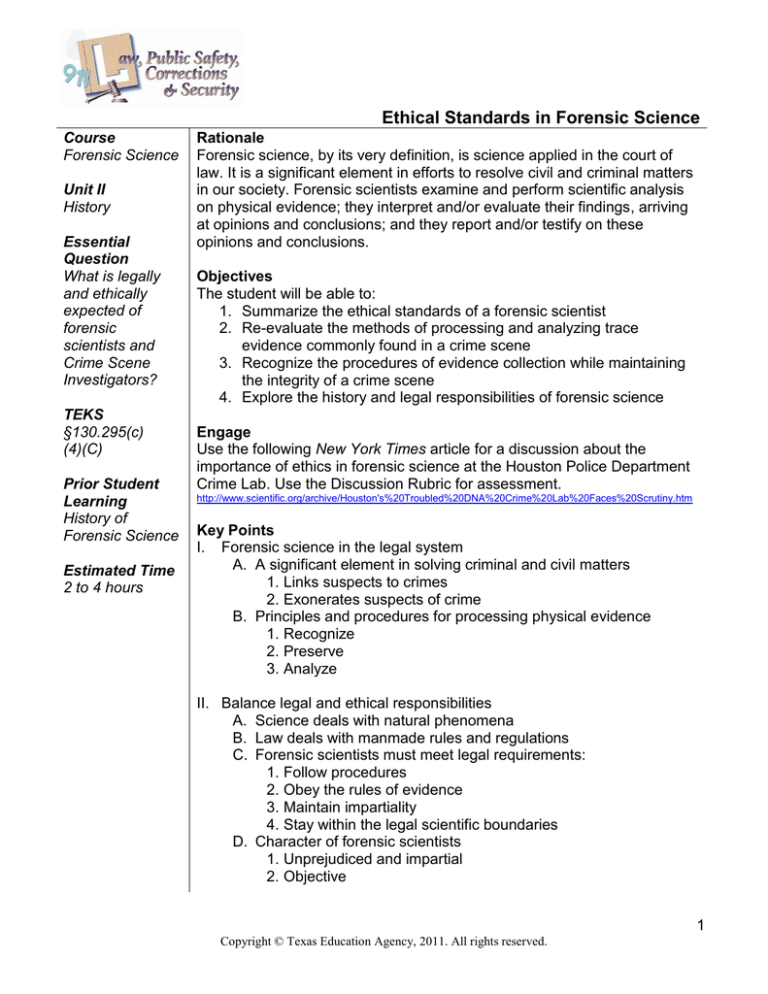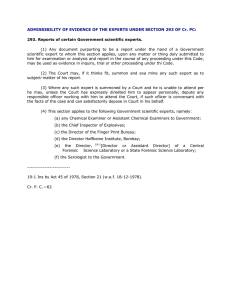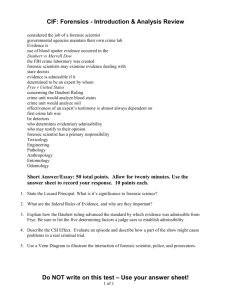Ethical Standards in Forensic Science
advertisement

Ethical Standards in Forensic Science Course Forensic Science Unit II History Essential Question What is legally and ethically expected of forensic scientists and Crime Scene Investigators? TEKS §130.295(c) (4)(C) Prior Student Learning History of Forensic Science Estimated Time 2 to 4 hours Rationale Forensic science, by its very definition, is science applied in the court of law. It is a significant element in efforts to resolve civil and criminal matters in our society. Forensic scientists examine and perform scientific analysis on physical evidence; they interpret and/or evaluate their findings, arriving at opinions and conclusions; and they report and/or testify on these opinions and conclusions. Objectives The student will be able to: 1. Summarize the ethical standards of a forensic scientist 2. Re-evaluate the methods of processing and analyzing trace evidence commonly found in a crime scene 3. Recognize the procedures of evidence collection while maintaining the integrity of a crime scene 4. Explore the history and legal responsibilities of forensic science Engage Use the following New York Times article for a discussion about the importance of ethics in forensic science at the Houston Police Department Crime Lab. Use the Discussion Rubric for assessment. http://www.scientific.org/archive/Houston's%20Troubled%20DNA%20Crime%20Lab%20Faces%20Scrutiny.htm Key Points I. Forensic science in the legal system A. A significant element in solving criminal and civil matters 1. Links suspects to crimes 2. Exonerates suspects of crime B. Principles and procedures for processing physical evidence 1. Recognize 2. Preserve 3. Analyze II. Balance legal and ethical responsibilities A. Science deals with natural phenomena B. Law deals with manmade rules and regulations C. Forensic scientists must meet legal requirements: 1. Follow procedures 2. Obey the rules of evidence 3. Maintain impartiality 4. Stay within the legal scientific boundaries D. Character of forensic scientists 1. Unprejudiced and impartial 2. Objective 1 Copyright © Texas Education Agency, 2011. All rights reserved. 3. Have sufficient education and training III. Main functions of forensic science A. Analyze – use scientific procedures to unearth factual information about the physical evidence in a case, regardless of which side the evidence supports B. Interpret – when examining and analyzing physical evidence, forensic scientists must interpret and/or evaluate their findings, arriving at opinions and conclusions C. Report – give a report and/or testify on these opinions and conclusions accurately and truthfully IV. Key Terms A. Forensic Science – the application of science to the criminal and civil laws that are enforced by police agencies in a criminal justice system B. Ethics – the branch of philosophy dealing with values relating to human conduct, with respect to the rightness and wrongness of certain actions, and to the goodness and badness of the motives and ends of such actions C. Physical evidence – any object that can establish that a crime has been committed, or can link a crime and its victim or its perpetrator D. Preservation – to keep possession of—to retain for safe keeping E. Rules of Evidence – govern whether, when, how, and for what purpose proof of a case may be placed before a court for consideration F. Impartiality – not partial or biased—fair or just G. Testimony – the statement or declaration of a witness under oath or affirmation, usually in court H. Expert Witness – the Forensic Scientist and or Crime Scene Technician presenting the findings of a crime investigation in a court of law I. Chain of Custody – refers to the chronological documentation, or paper trail, showing the seizure, custody, control, transfer, analysis, and disposition of physical or electronic evidence J. American Academy of Forensic Sciences – this is currently the largest forensic science organization in the world. Scientists may opt to follow the code of ethics from their regional professional organization or those from the American Academy of Forensic Sciences V. Establishing a professional standard A. Assessment is needed to standardize the process of collecting and examining physical evidence B. Ethical guidelines for analyzing physical evidence 1. Adequate examination 2 Copyright © Texas Education Agency, 2011. All rights reserved. 2. No excessive testing to needlessly enhance results 3. Use only methodology currently accepted in their field(s) of expertise at the time of the analysis 4. Use only valid, reliable, standard materials for comparison 5. Use accurate, reliable equipment that demonstrates precision and reproducibility C. Ethical guidelines for interpreting physical evidence 1. Do not confuse scientific facts with opinion in reports and testimony 2. Qualify and explain opinions and conclusions appropriately, especially in gray areas 3. Do not extend conclusions and opinions beyond the area(s) of personal expertise; don’t claim false qualifications 4. Assign the proper weight and certainty to opinions and conclusions D. Ethical guidelines for reporting conclusions 1. Never allow personal interest or gain to bias or distort a report or testimony 2. Never claim results and/or accomplishments not your own 3. Limit reports and/or testimony to the opinions and conclusions that can be properly drawn from the examinations and analyses 4. Avoid misleading or ambiguous language or terms easily misconstrued or misunderstood 5. Use currently accepted standards for photographs, posters, or background information; they should be undistorted and not sensational 6. Generally, the principle of the "attorney-client" relationship applies to the work of a forensic scientist, except in a situation where a miscarriage of justice might occur 7. Set a reasonable fee for services – never on a contingency basis E. Professional courtesy among peers and crime victims during an investigation 1. Re-examining evidence previously examined by another scientist is permissible; however, where a difference of opinion or conclusion arises, reasonable effort should be made by both scientists to resolve their conflict before the case goes to trial 2. A forensic scientist may advise an attorney regarding the direct and cross-examination, deposition, and interrogation of another forensic scientist, provided this service is performed in good faith, not malicious, and to prevent incompetent testimony 3. Make reasonable efforts to inform colleagues about new methodology or techniques for forensic examination and 3 Copyright © Texas Education Agency, 2011. All rights reserved. analysis, and report the discovery of invalid or unreliable methodology 4. Do not misrepresent or distort the statements, results, reports, testimony, or work of colleagues 5. Respect the opinions, conclusions, reports, and testimonies of colleagues unless you can prove that these opinions, conclusions, reports, or testimony are false or incorrect Activities Have students research the ethical principles related to the code of ethics and the professional practices of forensic science, for example: “Ethics and the expert witness” – an expert witness is a person who, because of education, training, or experience, possesses knowledge of a specialized nature beyond that of the average person on a factual matter and who may be expected to render an opinion within his/her expertise at a trial, i.e., a CSI technician testifying at a trial on the trace evidence found at a crime scene. Have students create and present their results to the class. Use the Presentation Rubric for assessment. Assessments Ethical Standards in Forensic Science Quiz and Key Discussion Rubric Individual Work Rubric Presentation Rubric Materials Ethical Standards in Forensic Science computer-based presentation Ethical Standards in Forensic Science Key Terms Poster boards and markers or computer-based presentation software Resources 0538445866, Forensic Science: Fundamentals and Investigations (2008), Anthony J. Bertino, South-Western Educational Publishing 0135045207, Criminalistics (10th Edition), Richard Saferstein, Prentice Hall http://www.uscourts.gov/rules/ http://www.truthinjustice.org/suttonDNA.htm http://www.lib.jjay.cuny.edu/cje/html/forensicscience.html Accommodations for Learning Differences For reinforcement, the student will match Key Terms to definitions using handouts prepared for them. Use the Individual Work Rubric for assessment. 4 Copyright © Texas Education Agency, 2011. All rights reserved. For enrichment, students will work in groups of two and create a student ethical standard outline on the ethics and legal aspects of Forensic Science, and discuss them in class. Use the Individual Work Rubric for assessment. State Education Standards Texas Essential Knowledge and Skills for Career and Technical Education §130.295. Forensic Science (One Credit). (4) The student explores the history, legal responsibilities, and career options for forensic science. The student is expected to: (C) summarize the ethical standards required of a forensic science professional; Career and College Readiness Standards English/Language Arts III. Speaking A. Understand the elements of communication both in informal group discussions and formal presentations 1. Understand how style and content of spoken language varies in different contexts and influences the listener’s understanding. 2. Adjust presentation to particular audiences and purposes. B. Develop effective speaking styles for both group and one-on-one situations. 1. Participate actively and effectively in one-on-one communication situations. 2. Participate actively and effectively in group discussions. 3. Plan and deliver focused and coherent presentations that convey clear 5 Copyright © Texas Education Agency, 2011. All rights reserved. Ethical Standards in Forensic Science Key Terms 1. Forensic Science – the application of science to the criminal and civil laws that are enforced by police agencies in a criminal justice system 2. Ethics – the branch of philosophy dealing with values relating to human conduct, with respect to the rightness and wrongness of certain actions, and to the goodness and badness of the motives and ends of such actions 3. Physical evidence – any object that can establish that a crime has been committed or link a crime and its victim or perpetrator 4. Preservation – to keep possession of or retain for safe keeping 5. Rules of Evidence – govern whether, when, how, and for what purpose proof of a case may be placed before a court for consideration 6. Impartiality – not partial or biased; fair or just 7. Testimony – the statement or declaration of a witness under oath or affirmation, usually in court 8. Expert Witness – the Forensic Scientist and or Crime Scene Technician presenting the findings of crime investigation in a court of law 9. Chain of Custody – refers to the chronological documentation or paper trail, showing the seizure, custody, control, transfer, analysis, and disposition of evidence, physical or electronic 10. American Academy of Forensic Sciences – this is currently the largest forensic science organization in the world. Scientists may opt to follow the code of ethics from their regional professional organization or those from the American Academy of Forensic Sciences 6 Copyright © Texas Education Agency, 2011. All rights reserved. Name________________________________ Date__________________________ Ethical Standards in Forensic Science Quiz True or False 1) Because science deals with natural phenomena, forensic scientists do not have to comply with legal requirements. 2) One of the basic functions of a forensic scientist is to provide important evidence for the prosecution. Fill in the blanks 3) _________________________ is the application of science to the criminal and civil laws that are enforced by police agencies in a criminal justice system. 4) The statement or declaration of a witness under oath or affirmation in court is a . 5) is any object that can establish that a crime has been committed, or can link a crime and its victim or its perpetrator. 6) Processing physical evidence includes recognizing, preserving, and ________________that evidence. Short Answers 7) List three main functions of a forensic scientist. 8) List three ethical guidelines for forensic scientists. 9) List one ethical guideline regarding professional courtesy among forensic scientists. Critical Thinking 10) Why is it important for forensic scientists to report what they observe, whatever they find, no matter what they believe? 7 Copyright © Texas Education Agency, 2011. All rights reserved. Ethical Standards in Forensic Science Quiz Key True or False 1) False 2) False Fill in the blank 3) Forensic science 4) Testimony 5) Physical evidence 6) Analyzing Short Answers 7) a) Analyzing physical evidence b) Interpreting test results (drawing conclusions) c) Writing reports and providing court testimony 8) Any three of the following: – Adequate examination – Lack of excessive testing to needlessly enhance results – Usage of methodology currently accepted in the field(s) of expertise – Usage of valid, reliable, standard materials for comparison – Usage of accurate, reliable equipment demonstrating precision and reproducibility – Lack of confusion of scientific facts with opinion in reports and testimony – Appropriate qualification and explanation of opinions and conclusions, especially in gray areas – No extension of conclusions and opinions beyond the area(s) of personal expertise – Assignation of the proper weight and certainty to opinions and conclusions expertise; no claim of any false qualifications – Never allowing personal interest or gain to bias or distort a report or testimony – Never claiming results and/or accomplishments not his or her own – Limitation of reports and/or testimony to the opinions and conclusions that can be properly drawn from the examinations and analyses – Avoidance of misleading or ambiguous language, or terms easily misconstrued or misunderstood – Usage of currently accepted standards for photographs, posters, or background information; they should be undistorted and not sensational – Application of the principle of the "attorney-client" relationship to the work of a forensic scientist, except in a situation where a miscarriage of justice might occur – Reasonable fees for services – never on a contingency basis 8 Copyright © Texas Education Agency, 2011. All rights reserved. 9) One of the following: – Reexamining evidence previously examined by another scientist is permissible; however, where a difference of opinion or conclusion arises, reasonable effort should be made by both scientists to resolve their conflict before the case goes to trial – A forensic scientist may advise an attorney regarding the direct and crossexamination, deposition, and interrogation of another forensic scientist, provided this service is performed in good faith, not maliciously, and to prevent incompetent testimony – Make reasonable efforts to inform colleagues about new methodology or techniques for forensic examinations and analyses, and report discovery of invalid or unreliable methodologies – Do not misrepresent or distort the statements, results, reports, testimony, or work of colleagues – Respect the opinions, conclusions, reports, and testimony of their colleagues unless you can prove that these opinions, conclusions, reports, or testimonies are false or incorrect Critical Thinking 10) Forensic scientists use scientific procedures to unearth factual information about the physical evidence in a case, regardless of which side the evidence supports. In order to be impartial, unprejudiced, and objective, they must report the facts as they find them. This might be difficult when conclusions are not clearly positive or negative. Forensic scientists often have to interpret their findings, arriving at opinions and conclusions about the physical evidence. 9 Copyright © Texas Education Agency, 2011. All rights reserved. Name_______________________________________ Date_______________________________ Discussion Rubric Objectives 4 pts. Excellent 3 pts. Good 2 pts. Needs Some Improvement 1 pt. Needs Much Improvement N/A Pts. Participates in group discussion Encourages others to join the conversation Keeps the discussion progressing to achieve goals Shares thoughts actively while offering helpful recommendations to others Gives credit to others for their ideas Respects the opinions of others Involves others by asking questions or requesting input Expresses thoughts and ideas clearly and effectively Total Points (32 pts.) Comments: 10 Copyright © Texas Education Agency, 2011. All rights reserved. Name______________________________________ Date_______________________________________ Individual Work Rubric 4 pts. Excellent Objectives 3 pts. Good 2 pts. Needs Some Improvement 1 pt. Needs Much Improvement N/A Pts. Follows directions Student completed the work as directed, following the directions given, in order and to the level of quality indicated Time management Student used time wisely and remained on task 100% of the time Organization Student kept notes and materials in a neat, legible, and organized manner. Information was readily retrieved Evidence of learning Student documented information in his or her own words and can accurately answer questions related to the information retrieved *Research/Gathering information (if relevant) Student used a variety of methods and sources to gather information. Student took notes while gathering information Total Points (20 pts.) Comments: 11 Copyright © Texas Education Agency, 2011. All rights reserved. Name:____________________________________ Date:_____________________________ Presentation Rubric 4 pts. Excellent Objectives 3 pts. Good 2 pts. Needs Some Improvement 1 pt. Needs Much Improvement N/A Pts. Topic/Content Topic discussed completely and in-depth Includes properly cited sources (if used) Creativity/Neatness Integrates a variety of multimedia effects to create a professional presentation (transition and graphics) or appropriate visual aid used Title slide, table of contents, bibliography are included, using acceptable format Mechanics Grammar, spelling, punctuation, and capitalization are correct Image and font size are legible to the entire audience Oral Presentation Communicates with enthusiasm and eye contact Voice delivery and projection are dynamic and audible Audience Interaction Presentation holds audience’s attention and relates a clear message Clearly and effectively communicates the content throughout the presentation Total Points (20 pts.) Comments: 12 Copyright © Texas Education Agency, 2011. All rights reserved.






